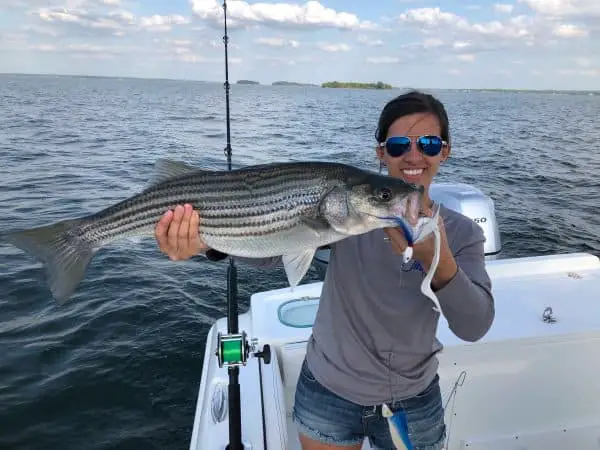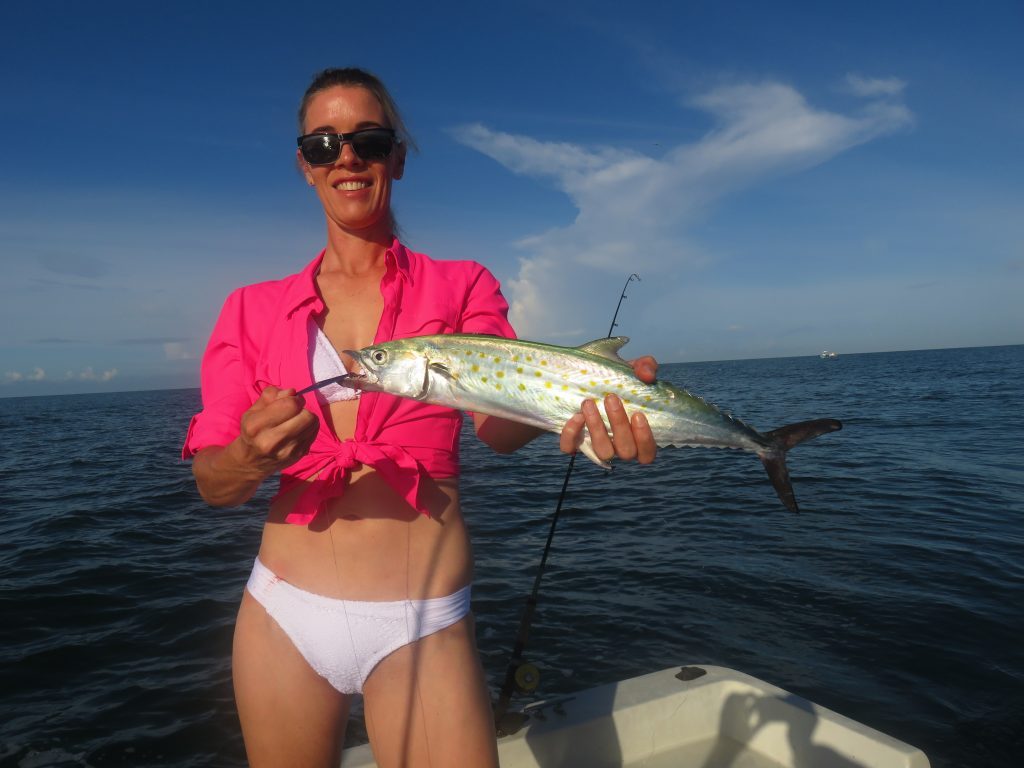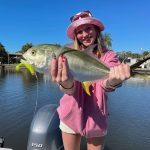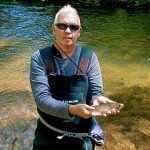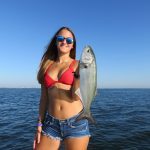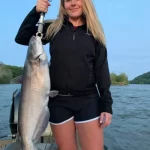Saltwater Fishing with Lures
Many anglers go saltwater fishing with artificial lures instead of live or cut bait. This is a list of the best 6 saltwater fishing lures. Artificial lures have been used by anglers to catch fish for a very long time. Lures are designed to mimic the forage that fish feed on. In saltwater, that is primarily bait fish and crustaceans such as crabs and shrimp.
The best 6 saltwater fishing lures are:
-
the jig and grub combo
-
buck tail jigs
-
Gulp! baits
-
shallow diving plugs
-
spoons
-
topwater plugs
These six lure types are very versatile and will cover every situation than a saltwater angler will encounter. They will also catch every species that will take a lure.
Anglers are often surprised to find that lures commonly out fish live bait. While live bait is effective when fish are hungry, lures have other advantages. They will trigger reaction strikes from fish that are perhaps not feeding but can’t resist the chance for an easy meal. Artificial lures also allow anglers to cover a lot more water than those fishing with live bait. Finally, there is a convenience factor of not having to purchase, catch, and keep bait alive.
Best 6 Saltwater Fishing Lures
There are many artificial lures on the market that will catch fish. These are Capt Jim’s top 6 saltwater fishing lures that he uses on his Sarasota fishing charters.
1) Jig and grub combo is the best saltwater fishing lure
The jig and grub combination is arguably the most popular saltwater fishing lure. It is #1 on Capt Jim’s list of the top 6 saltwater fishing lures. It is economical, versatile, and will produce anywhere on the planet. This lure basically consists of a hook with a lead head molded into it near the eye. This weight at the front causes the lure to hop and fall in a jigging fashion. That is how the lure got its name. Jig heads come in many different sizes, shapes, and colors. However, they all work the same.
The jig head is chosen based on the conditions the angler is facing. Depth of the water, speed of the current, and size of the forage are the primary considerations. Anglers fishing in water shallower than 10 feet deep will find a quarter ounce jig to be a good all-around size. Anglers fishing in deeper water and in current will need to bump up the jig head size accordingly.
Some type of soft plastic grub body is added to the jig head. These tails come in a myriad of styles, sizes, and colors. The goal is for the grub body to match the forage. The most popular tail shapes are shrimp tails, shad tails, and curly tails. All three designs are effective, however the latter two have more built in action. A 1/4 ounce jig head with a 4 inch shad tail body is a great all round saltwater fishing lure. However, it is not uncommon for anglers seeking large fish such as striped bass to go much larger.
Jigs are economical and versatile
Versatility is one of the key components to the popularity of the jig and grub combo. They can be retrieved in a variety of ways throughout the entire water column. A jig with a shrimp tail can be bounced off the bottom, imitating a shrimp or crab. Jigs with a bait style tail can be retrieve steadily through the water. They can be cast to fish that are breaking on the surface and worked quickly. Trolling with these lures can be quite productive.
The most common and productive retrieve for most anglers is the “jig and fall”retrieve. The lure is cast out and allowed to sink several seconds. The rod tip is then jerked sharply upwards, causing the lure to shoot up through the water column. With the rod tip held high, the retrieve is paused, allowing the lure to flutter helplessly through the water. Most strikes occur on the fall as the jig resembles a helpless or wounded bait fish.
The jig and grub combo is a fantastic lure for anglers targeting breaking fish. These are fish that are actively feeding on the surface such as bluefish, striped bass, and Spanish mackerel. As long as the grub remotely resembles the size of the forage, they will usually draw a strike. The jig and grub is also very effective when trolled. Striped bass in particular fall prey to a shad tail jig trolled along a channel edge. Anglers can scroll down to read more about fishing with jigs.
Capt Jim’s preferred saltwater soft plastic artificial lure is the Bass Assassin 4″ Sea Shad. It comes in a huge variety of colors and has an excellent swimming action in the water. His favorite colors are Glow/chartreuse, New Penny, and Red/gold shiner, but ever angler will have her or her personal favorite baits.
2) Bucktail jigs are excellent saltwater fishing lures
Bucktail jigs are extremely productive for anglers fishing saltwater. In fact, they are one of the first saltwater fishing lures. White is a most popular color. They are very effective and are fished in the same manner as the jig and grub combo. As with the jig and grub, sizes determined by the water being fished and the available forage. Anglers can combine the two and add a soft plastic tail to add even more action. This is deadly on striped bass. There are a couple of factors that put them slightly behind the jig and grub.
Bucktail jigs are a bit more expensive and less versatile than the jig and grub combo. Anglers catching toothy species such as mackerel and bluefish can spend a lot of money quickly as these fish will tear up a buck tail jig. Plastic grub tails are inexpensive and easily replaced. Also, bucktail jigs are less versatile. While it is very easy to change the color or shape of a plastic tailed lure, this is not the case with bucktail. However, bucktail and synthetic hair jigs have great action and the water and you catch a lot of fish. They are #2 on the list of top 6 saltwater fishing lures.
Capt Jim’s preferred saltwater buck tail jig is manufactured by Spro. These are high quality lures that are as durable as a buck tail jig can be.
3) Gulp baits, scent is the key to success
While they may seem to just be another soft plastic bait, that is not the case. The Gulp line of baits are extremely productive. They have a built-in scent that makes fishing them almost like using live bait. In Florida, the 3 inch Gulp Shrimp is a deadly bait on the shallow grass flats. Anglers all over the country use them with success. As with all lures, the key is to match the color and size of the bait to the available forage.
Anglers fishing shallow water can fish the Gulp Shrimp under a popping cork. This is an extremely productive technique for speckled trout and redfish on the grass flats between 2 feet deep and 6 feet deep. The cork makes a pop or rattle which attracts game fish. When fish come to investigate, they see the shrimp below the cork and eat it. Most anglers fish the Gulp Shrimp on a jig head, just as they would with any soft plastic bait. This certainly is the best approach in deeper water.
The 5″ Gulp Jerk Shad is a very versatile bait. It is effective on the deep flats and tends to catch larger trout and other species. It is also very productive for anglers fishing shallow for snook, reds, and jacks. It also works great when fishing docks. They can be worked shallow on a swimbait hook or deeper on a jig head. Gulp! baits are #3 on the list of top 6 saltwater fishing lures.
4) Shallow diving plugs are effective saltwater fishing lures
These lures are extremely effective for anglers saltwater fishing. They imitate bait fish. Plugs vibrate and wobble, mimicking a wounded or injured bait. This triggers the natural instinct and fish to attack. Rapala X-Raps and Yo-Zuri Crystal Minnows are examples of popular shallow diving plugs. Some anglers refer to these as twitch baits or jerk baits due to their action and the water. They are #4 on the list of top 6 saltwater fishing lures.
Shallow diving plugs can be cast or trolled effectively. Anglers working shoreline cover or casting open flats catch a variety of species. The best retrieve is generally an erratic one. The lure will float on the surface at rest, then dive down when retrieved. Several cranks of the reel handle followed by a twitch and a pause is a very effective retrieve. At other times a steady retrieve, either slow or quite fast, will produce. Once again, it is important to match the size and color of the lure to the bait fish that are prevalent in the area. Local tackle shops will have a good selection of baits that work well in their local waters.
These plugs really come into their own when fish are working on the surface. Spanish mackerel, bluefish, stripers, false albacore, and other species will devour them. Plugs come in many sizes and colors, making it easy to “match the hatch”.
Capt Jim’s favorite plug is the Rapala X-Rap Extreme Action Slashbait. He prefers the 08 size when fish are feeding on smaller bait and the 10 size when larger forage is present. White and olive are his top colors.
5) Spoons are versatile saltwater fishing lures
Spoons are a very simple looking artificial lure, yet one of the most productive. A spoon is basically a curved piece of metal with a hook in it. Spoons resemble a wounded bait fish. Metallic finishes such as silver, copper, brass, and gold are popular. Spoons can also be painted or have reflective material on them. Casting and trolling both produce a lot a fish. They are #5 on the list of top 6 saltwater fishing lures.
Spoons cast a long way. They are relatively heavy and aerodynamic. 1/2 ounce to 3/4 ounce spoons are very popular as they mimic small shiny fish such as sardines. The spoon is cast out, allowed to sink, then worked back using either a steady or erratic retrieve. As with all lure fishing, it is best to experiment with retrieves until a productive pattern emerges.
Click this link to read Capt Jim’s article on saltwater fishing with spoons
Anglers fishing very shallow water do well with a weedless spoon. The Johnson Silver Minnow is an example of this. It is an established lure that has been around for decades, starting out in freshwater for anglers targeting largemouth bass. The weedless spoon is a staple of flats anglers in the south targeting redfish on shallow grass flats. It has a single hook that rides up, resulting in less snags on the bottom.
Capt Jim’s favorite casting spoons are the Johnson Sprite and Johnson Silver Minnow. The Sprite is an open water spoon with a treble hook while the Silver Minnow is weedless.
Swivels are required when fishing with spoons
Anglers using spoons will need to use some type of swivel. Spoon will spin in the water, causing line twist. There are two options when choosing a swivel. Anglers can tie a barrel swivel onto the end of the running line, then use a short section of leader between the spoon and the other end of the swivel. Another option is the snap swivel right at the lure. This allows for easy changing of the spoon. Either method will work fine in eliminate line twist.
Spoons can also be used for vertical jigging. The Hopkins Jigging Spoon is an example of this lure. This is an extremely effective technique when fish are schooled up in deep water over structure such as a wreck or a channel edge. Just about any game fish can be caught on these lures.
Trolling spoons
There is a special type of spoon designed specifically for trolling. These are long and slender and have a very tight wobble, allowing anglers to troll at speeds approaching 10 knots. They are extremely productive for striped bass, Spanish mackerel, king mackerel, false albacore, bluefish, and other species.
Trolling spoons generally need some type of device to get them down in the water column. The three methods used most often are downriggers, trolling weights, and planers. All three methods work and have their advantages and disadvantages.
Trolling sinkers are the easiest method to get a spoon down in the water column. The specially designed sinker is tied to the running line and then a leader is used between the sinker and the spoon. Leader lengths vary, but are generally fairly long, around 20 feet. As the angler reels the fish in, they must stop when the sinker hits the rod tip and the fishes in hand lined in the rest of the way.
Trolling with planers
Planers are a clever device that will take the spoon down to a specific depth. A #1 planer will go down 5 to 7 feet, a #2 planer down to 12 to 15 feet, and a #3 planer will go down to 25 feet. The larger the planer, the more stout the tackle is required as the planer puts quite a strain on the rod. When a fish hits, the planer “trips”allowing the angler to fight the fish without the drag. As with the sinker, the fish must be hand lined in the last 20 feet or so.
Downriggers are expensive, complicated devices that will take the lure down to the desired depth. However, fast trolling speeds will result in the ball swinging up, reducing the depth. Downriggers are expensive and complicated and are generally only used by fairly serious anglers.
6) Topwater plugs are exciting to fish
Topwater plugs are lures that float on the surface and stay there when being retrieved. Most are made of plastic though a few are manufactured out of balsa wood. There are several different styles; poppers, prop baits, and walk-the-dog baits. Top water plugs can be very effective at times and will draw some explosive strikes. Many anglers prefer using top water plugs just for the sheer fun of it. they are # 6 on the list of top 6 saltwater fishing lures.
Poppers have been around a long time and are very effective. They also have the most built in action. They have a concave face which results in a loud “pop” when the lure is twitched sharply. Many fish find this action irresistible. Surf casters targeting striped bass and bluefish on the East Coast beaches will use very large versions of these. They are effective and saltwater all over the world.
Prop baits have propellers on them, either for, after, or both. They put out a lot of commotion when twitched sharply. Prop eight seem to work best when fished along shorelines and other structure. They have been catching largemouth bass in freshwater for many years.
Walk-the-dog baits are cylindrical with a tapered nose. They do not have a lot of built in action. The angler must impart the action in order to draw strike. The retrieve is a bit more difficult to master than other top water baits. The rod tip is held low and twitched gently as the reel handle is turned. This results in the lure moving a few inches and darting side-to-side. This action is deadly, particularly over shallow flats.
Capt Jim’s favorite topwater plug is the Rapala Skitter Prop. It puts out a lot of commotion and noise and is very easy to fish. Chrome is a good all round color.
Jig fishing tips and techniques
This article shares jig fishing tips and techniques. Jigs are a simple but very effective lure that will catch just about every freshwater and saltwater species.
There is evidence pointing to the jig as being the first artificial fishing lure. A jig is basically a hook with some type of weight near the eye and a plastic tail or hair dressing. The lure is retrieved using a twitch and pause. This causes the jig to hop up then fall seductively through the water column. That is how it gets its name. Jigs can imitate both bait fish and crustaceans such as shrimp and crabs.
Jigs come in countless sizes, shapes, and colors. However, there are two basic styles. There is the jig and grub combo and buck tail style jigs. Both have their advantages. Jigs also come in numerous weights and lengths. Heavier jigs allow anglers to fish deeper water. As in all fishing, the jigs should match the available forage.
Jig and grub fishing techniques
The jig and grub is very versatile. With this system, anglers purchase the jig head in the plastic body separately. This allows for constant changing of colors and lengths as well as styles. This is a very productive system that works well anywhere on the planet.
Here on the Gulf Coast of Florida where I fish, the jig and grub is the most popular artificial lure. One quarter ounce jig heads are the most popular as the water is fairly shallow. Anglers fishing deeper water or places were current is present will need heavier jig heads. Red, white, and chartreuse are three of the more popular jig head colors.
Soft plastic tails are used with the jig. These also come in endless styles and colors. Shad tail, curly tail, paddle tail, and jerk worm styles all produce. While there are many different varieties, they all imitate either a bait fish or a crustacean of some sort. A jig head with a shad tail body is probably the most commonly used combination.
Shad tails and curly tail grubs have a great built in action. The tails look very natural when they are moving through the water. Curly tails are more popular in fresh water while shad tails are the choice in salt. Paddle tails and jerk worms require the action to be imparted by the angler.
Fishing with hair jigs
Hair jigs are also very popular. Buck tail jigs were the original types used and were made from dear hair. They are still available and are still very effective. Freshwater anglers have used marabou hair on their jigs for decades. It has great action but does not hold up as well as buck tail does. Synthetic care jigs have become very popular in the last 10 or 15 years. They work well and are more durable than some of the other dressings.
Jig fishing catch just about every species on the planet. A jig can be used to mimic just about any type of forged that a fish feeds on. There are also several different techniques that anglers jig fishing use to be productive. Jigs can be cast, vertically fished, and trolled.
Vertically fishing with jigs is effective
Vertical presentations catch a lot of fish. This technique is very easy to master. Vertical jigging is done in deeper water. The jig is simply dropped down to the bottom and then the lure is worked vertically. This action, where it hops up and falls naturally, is an excellent presentation. I do this often on my fishing charters in the passes. Clients do not even have to be able to cast to catch fish.
This is often done from a drifting boat. Drifting allows anglers to cover a lot of water efficiently. No time is wasted as the bait spends the entire time in the strike zone. Most fish are found on or near the bottom. Anglers can also use a trolling motor to work a drop off or other structure.
Freshwater anglers have been employing this technique for decades. Bass, walleye, striped bass, trout, and really any species that holds on deeper structure can be caught using this approach. However, it is not practical in shallow water as the boat will spook the fish.
Casting jigs for success
Most fish caught on jigs are done so by anglers casting jigs. This is the most effective technique when fishing water ten feet deep or less. The jig is cast out, allowed to sink, and then worked back to the boat. The most productive retrieve is usually one where the jig is worked near the bottom.
However, as with all lure fishing, the retrieve should be varied until a productive pattern emerges. At times a steady retrieve will produce well. When fish are working on the surface, a fast, erratic retrieve will usually work the best.
The jig and grub combo is by far the most popular lure along the southeast coastal United States. Anglers from Virginia to Texas use these baits to fool a variety of species. The low cost and versatility of the jig and grub combo makes them an easy choice.
Speckled trout are arguable the most popular inshore Gulf species. The jig and grub is well suited to target trout. Most specks are found over submerged grass beds in 4′ to 10′ of water. Jigs cast and retrieved over these grass flats produce trout, reds, and other species. I find them especially productive I cooler water.
Live bait fishing with jigs
Jigs can also e used in conjunction with live bait. This is a long proven technique in both fresh and salt water. In Florida where I guide, we often add a piece of shrimp to the lure. We call this “tipping the jig”. It can really make the difference when the water is cold or dirty. The extra scent helps the fish find the bait.
The jig and minnow has been producing fish for freshwater anglers for a long time. A marabou jig with a small minnow hooked through the lips is a terrific combination. The lure bait combo is deadly when slowly bounced along bottom structure. It can be cast out or vertically fished.
Trolling with jigs is a productive technique
Anglers jig fishing also do well when trolling. I grew up in fishing the Chesapeake Bay. Anglers trolling white buck tail jigs for striped bass achieve success. Bluefish and other species will take a trolled jig. The primary issue when trolling jigs is to make sure the lure does not spin, which will cause line twist.
Freshwater anglers recognize the value of trolling jigs as well. Crappie fisherman have mastered this technique. A small jig trolled over submerged structure is deadly on these largest members of the panfish family. Anglers use long, specially designed rods to present multiple baits out in a spread.
There are many lure manufacturers out there. They are will produce fish when presented properly. My personal favorite line of baits in from Bass Assassin. They make a wide variety of baits and colors that cover every angling application, from pan fish to salt water.
Scented jigs are very effective fishing lures
Scented soft plastic baits have become very popular, and with good reason. These baits produce for jig fishing! The Gulp! line of baits is the industry leader, in my opinion. The Gulp! Shrimp has produced many fish for me and my clients over the years. Freshwater anglers experience similar results. They do cost a little bit more money, but on days when the bite is tough, they can make all of the difference.
In conclusion, this article on the best 6 saltwater fishing lures will help anglers become more versatile and more importantly, catch more fish!

